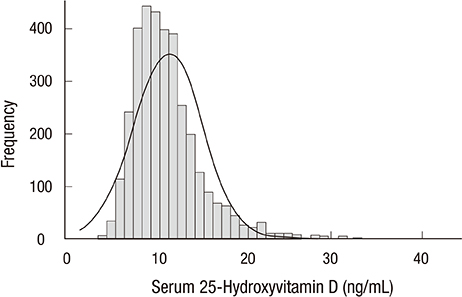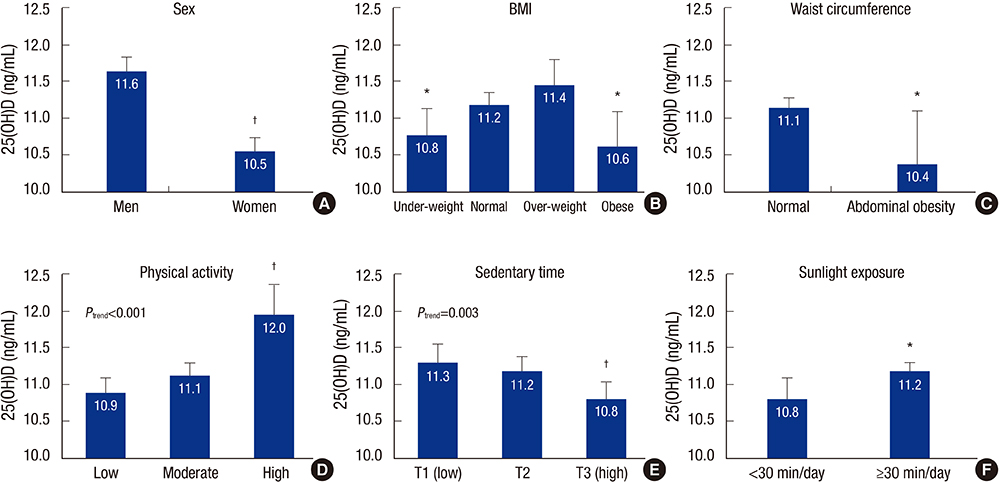J Korean Med Sci.
2015 Aug;30(8):1110-1120. 10.3346/jkms.2015.30.8.1110.
Lifestyle and Dietary Factors Associated with Serum 25-Hydroxyvitamin D Levels in Korean Young Adults
- Affiliations
-
- 1Department of Medicine, Seoul National University College of Medicine, Seoul, Korea.
- 2Department of Family Medicine, Seoul National University Health Service Center, Seoul, Korea.
- 3Department of Internal Medicine, Seoul National University Boramae Medical Center, Seoul, Korea.
- 4Department of Family Medicine and Health Promotion Center, Seoul National University Hospital, Seoul, Korea. belong@snu.ac.kr
- 5Advanced Institutes of Convergence Technology, Seoul National University, Seoul, Korea.
- 6Institute on Aging, Seoul National University College of Medicine, Seoul, Korea.
- KMID: 2164506
- DOI: http://doi.org/10.3346/jkms.2015.30.8.1110
Abstract
- Inadequate vitamin D status is highly prevalent in the Korean population, especially among young adults. Nonetheless, correlates of suboptimal vitamin D levels in young adults are not well defined. This study aimed to investigate potentially modifiable determinants of vitamin D levels in young adults in Korea. This cross-sectional study was based on health check-up data from 3,450 healthy male and female university students aged 18-29 yr in Seoul between April and May 2013. Serum 25-hydroxyvitamin D [25(OH)D] levels were determined using chemiluminescent immunoassay. Anthropometric data were measured, and lifestyle, dietary, and sociodemographic factors were obtained through self-administered questionnaires. General linear regression was used to assess correlates of serum 25(OH)D levels. The mean serum 25(OH)D level was 11.1 ng/mL, and the prevalence of 25(OH)D levels less than 10 ng/mL was 44.7% (39.5% in men, 50.2% in women). In a final multivariable model, significant positive correlates of serum 25(OH)D were older age, male sex, increased physical activity, sunlight exposure > or = 30 min/day, eating breakfast regularly, consumption of dairy and fatty fish, and use of vitamin D-containing supplements. In contrast, significant inverse correlates were obesity (body mass index, BMI > or = 25 kg/m2) or underweight (BMI < 18.5 kg/m2), abdominal obesity, increased sedentary time, and frequent consumption of instant noodles and sugar-sweetened beverages. In conclusion, many modifiable lifestyle and dietary factors were associated with low serum 25(OH)D levels in Korean young adults. Further studies on potential mechanisms of the correlates and optimal strategies to improve vitamin D status in this vulnerable subpopulation are warranted.
Keyword
MeSH Terms
-
Administration, Oral
Adolescent
Adult
Age Distribution
Dietary Supplements/*statistics & numerical data
*Feeding Behavior
Female
Health Behavior
Humans
Life Style
Male
Prevalence
Republic of Korea/epidemiology
Risk Assessment
Sex Distribution
Vitamin D/*administration & dosage/*analogs & derivatives/blood
Vitamin D Deficiency/*blood/*epidemiology/prevention & control
Young Adult
Vitamin D
Figure
Cited by 2 articles
-
Dietary Life, Vitamin D Status and Blood Clinical Indices of University Laboratory Workers
Jung Hyun Hwang, Hong Mie Lee, Jung Hee Kim
Korean J Community Nutr. 2019;24(3):245-256. doi: 10.5720/kjcn.2019.24.3.245.The factors associated with Vitamin D deficiency in community dwelling elderly in Korea
Sun Hea Kim, Jung Eun Oh, Dong Won Song, Choo Yon Cho, Sung Ho Hong, Yong Jin Cho, Byung Wook Yoo, Kyung Suk Shin, Hyun Joe, Hwang Sik Shin, Doo Yong Son
Nutr Res Pract. 2018;12(5):387-395. doi: 10.4162/nrp.2018.12.5.387.
Reference
-
1. Holick MF. Vitamin D deficiency. N Engl J Med. 2007; 357:266–281.2. Choi HS, Oh HJ, Choi H, Choi WH, Kim JG, Kim KM, Kim KJ, Rhee Y, Lim SK. Vitamin D insufficiency in Korea--a greater threat to younger generation: the Korea National Health and Nutrition Examination Survey (KNHANES) 2008. J Clin Endocrinol Metab. 2011; 96:643–651.3. Choi EY. 25(OH)D status and demographic and lifestyle determinants of 25(OH)D among Korean adults. Asia Pac J Clin Nutr. 2012; 21:526–535.4. Langlois K, Greene-Finestone L, Little J, Hidiroglou N, Whiting S. Vitamin D status of Canadians as measured in the 2007 to 2009 Canadian Health Measures Survey. Health Rep. 2010; 21:47–55.5. Prentice A. Vitamin D deficiency: a global perspective. Nutr Rev. 2008; 66:S153–S164.6. Han SW, Kim SJ, Lee DJ, Kim KM, Joo NS. The Relationship between Serum 25-Hydroxyvitamin D, Parathyroid Hormone and the Glomerular Filtration Rate in Korean Adults: The Korea National Health and Nutrition Examination Survey between 2009 and 2011. Korean J Fam Med. 2014; 35:98–106.7. Bjelakovic G, Gluud LL, Nikolova D, Whitfield K, Krstic G, Wetterslev J, Gluud C. Vitamin D supplementation for prevention of cancer in adults. Cochrane Database Syst Rev. 2014; 6:CD007469.8. Wang L, Song Y, Manson JE, Pilz S, März W, Michaëlsson K, Lundqvist A, Jassal SK, Barrett-Connor E, Zhang C, et al. Circulating 25-hydroxy-vitamin D and risk of cardiovascular disease: a meta-analysis of prospective studies. Circ Cardiovasc Qual Outcomes. 2012; 5:819–829.9. Hyppönen E, Cavadino A, Williams D, Fraser A, Vereczkey A, Fraser WD, Bánhidy F, Lawlor D, Czeizel AE. Vitamin D and pre-eclampsia: original data, systematic review and meta-analysis. Ann Nutr Metab. 2013; 63:331–340.10. Bergman P, Lindh AU, Björkhem-Bergman L, Lindh JD. Vitamin D and respiratory tract infections: a systematic review and meta-analysis of randomized controlled trials. PLoS One. 2013; 8:e65835.11. Salamoun MM, Kizirian AS, Tannous RI, Nabulsi MM, Choucair MK, Deeb ME, El-Hajj Fuleihan GA. Low calcium and vitamin D intake in healthy children and adolescents and their correlates. Eur J Clin Nutr. 2005; 59:177–184.12. Jääskeläinen T, Knekt P, Marniemi J, Sares-Jäske L, Männistö S, Heliövaara M, Järvinen R. Vitamin D status is associated with sociodemographic factors, lifestyle and metabolic health. Eur J Nutr. 2013; 52:513–525.13. McCullough ML, Weinstein SJ, Freedman DM, Helzlsouer K, Flanders WD, Koenig K, Kolonel L, Laden F, Le Marchand L, Purdue M, et al. Correlates of circulating 25-hydroxyvitamin D: Cohort Consortium Vitamin D Pooling Project of Rarer Cancers. Am J Epidemiol. 2010; 172:21–35.14. Choi HS. Vitamin d status in Korea. Endocrinol Metab (Seoul). 2013; 28:12–16.15. Lee YA, Kim HY, Hong H, Kim JY, Kwon HJ, Shin CH, Yang SW. Risk factors for low vitamin D status in Korean adolescents: the Korea National Health and Nutrition Examination Survey (KNHANES) 2008-2009. Public Health Nutr. 2014; 17:764–771.16. World Health Organization Western Pacific Region, International Association for the Study of Obesity, International Obesity Task Force. The Asia-Pacific perspective: redefining obesity and its treatment. Sydney: Health Communications Australia Pty;2000.17. Lee SY, Park HS, Kim DJ, Han JH, Kim SM, Cho GJ, Kim DY, Kwon HS, Kim SR, Lee CB, et al. Appropriate waist circumference cutoff points for central obesity in Korean adults. Diabetes Res Clin Pract. 2007; 75:72–80.18. International Physical Activity Questionnaire (IPAQ) Research Committee. Guidelines for data processing and analysis of the International Physical Activity Questionnaire (IPAQ)-short and long forms. accessed on June 29, 2015. Available at http://www.academia.edu/5346814/Guidelines_for_Data_Processing_and_Analysis_of_the_International_Physical_Activity_Questionnaire_IPAQ_Short_and_Long_Forms_Contents.19. Yu A, Kim J, Kwon O, Oh SY, Kim J, Yang YJ. The association between serum 25-hydroxyvitamin d concentration and consumption frequencies of vitamin d food sources in Korean adolescents. Clin Nutr Res. 2013; 2:107–114.20. Wei MY, Giovannucci EL. Vitamin D and multiple health outcomes in the Harvard cohorts. Mol Nutr Food Res. 2010; 54:1114–1126.21. Kühn T, Kaaks R, Teucher B, Hirche F, Dierkes J, Weikert C, Katzke V, Boeing H, Stangl GI, Buijsse B. Dietary, lifestyle, and genetic determinants of vitamin D status: a cross-sectional analysis from the European Prospective Investigation into Cancer and Nutrition (EPIC)-Germany study. Eur J Nutr. 2014; 53:731–741.22. van Dam RM, Snijder MB, Dekker JM, Stehouwer CD, Bouter LM, Heine RJ, Lips P. Potentially modifiable determinants of vitamin D status in an older population in the Netherlands: the Hoorn Study. Am J Clin Nutr. 2007; 85:755–761.23. Larose TL, Chen Y, Camargo CA Jr, Langhammer A, Romundstad P, Mai XM. Factors associated with vitamin D deficiency in a Norwegian population: the HUNT Study. J Epidemiol Community Health. 2014; 68:165–170.24. Hintzpeter B, Mensink GB, Thierfelder W, Mller MJ, Scheidt-Nave C. Vitamin D status and health correlates among German adults. Eur J Clin Nutr. 2008; 62:1079–1089.25. Clements MR, Johnson L, Fraser DR. A new mechanism for induced vitamin D deficiency in calcium deprivation. Nature. 1987; 325:62–65.26. Shin HJ, Cho E, Lee HJ, Fung TT, Rimm E, Rosner B, Manson JE, Wheelan K, Hu FB. Instant noodle intake and dietary patterns are associated with distinct cardiometabolic risk factors in Korea. J Nutr. 2014; 144:1247–1255.27. Tucker KL, Morita K, Qiao N, Hannan MT, Cupples LA, Kiel DP. Colas, but not other carbonated beverages, are associated with low bone mineral density in older women: The Framingham Osteoporosis Study. Am J Clin Nutr. 2006; 84:936–942.28. Kit BK, Fakhouri TH, Park S, Nielsen SJ, Ogden CL. Trends in sugar-sweetened beverage consumption among youth and adults in the United States: 1999-2010. Am J Clin Nutr. 2013; 98:180–188.29. McGartland C, Robson PJ, Murray L, Cran G, Savage MJ, Watkins D, Rooney M, Boreham C. Carbonated soft drink consumption and bone mineral density in adolescence: the Northern Ireland Young Hearts project. J Bone Miner Res. 2003; 18:1563–1569.30. Mahmood M, Saleh A, Al-Alawi F, Ahmed F. Health effects of soda drinking in adolescent girls in the United Arab Emirates. J Crit Care. 2008; 23:434–440.31. Wyshak G. Teenaged girls, carbonated beverage consumption, and bone fractures. Arch Pediatr Adolesc Med. 2000; 154:610–613.32. Harnack L, Stang J, Story M. Soft drink consumption among US children and adolescents: nutritional consequences. J Am Diet Assoc. 1999; 99:436–441.33. Milne DB, Nielsen FH. The interaction between dietary fructose and magnesium adversely affects macromineral homeostasis in men. J Am Coll Nutr. 2000; 19:31–37.34. Peters BS, Verly E Jr, Marchioni DM, Fisberg M, Martini LA. The influence of breakfast and dairy products on dietary calcium and vitamin D intake in postpubertal adolescents and young adults. J Hum Nutr Diet. 2012; 25:69–74.35. Douard V, Patel C, Lee J, Tharabenjasin P, Williams E, Fritton JC, Sabbagh Y, Ferraris RP. Chronic high fructose intake reduces serum 1,25 (OH)2D3 levels in calcium-sufficient rodents. PLoS One. 2014; 9:e93611.36. Hill KM, Jonnalagadda SS, Albertson AM, Joshi NA, Weaver CM. Top food sources contributing to vitamin D intake and the association of ready-to-eat cereal and breakfast consumption habits to vitamin D intake in Canadians and United States Americans. J Food Sci. 2012; 77:H170–H175.37. Yoo KB, Suh HJ, Lee M, Kim JH, Kwon JA, Park EC. Breakfast eating patterns and the metabolic syndrome: the Korea National Health and Nutrition Examination Survey (KNHANES) 2007-2009. Asia Pac J Clin Nutr. 2014; 23:128–137.38. Korea Ministry of Health and Welfare, Korea Centers For Disease Control and Prevention. Korea Health Statistics 2013: Korea National Health and Nutrition Examination Survey (KNHANESVI-1). Cheongwon: Korea Centers for Disease Control and Prevention;2014.39. Winzenberg T, Powell S, Shaw KA, Jones G. Effects of vitamin D supplementation on bone density in healthy children: systematic review and meta-analysis. BMJ. 2011; 342:c7254.40. Hirani V, Mosdøl A, Mishra G. Predictors of 25-hydroxyvitamin D status among adults in two British national surveys. Br J Nutr. 2009; 101:760–764.
- Full Text Links
- Actions
-
Cited
- CITED
-
- Close
- Share
- Similar articles
-
- Serum 25-Hydroxyvitamin D Status and Associated Factors in Premenopausal Working Women
- Vitamin D Status and Its Association with the SCORAD Score and Serum LL-37 Level in Korean Adults and Children with Atopic Dermatitis
- Effects of sun exposure and dietary vitamin D intake on serum 25-hydroxyvitamin D status in hemodialysis patients
- Vitamin D Status in Korea
- Prevalence of and Risk Factors for Hypovitaminosis D in Patients with Rotator Cuff Tears




